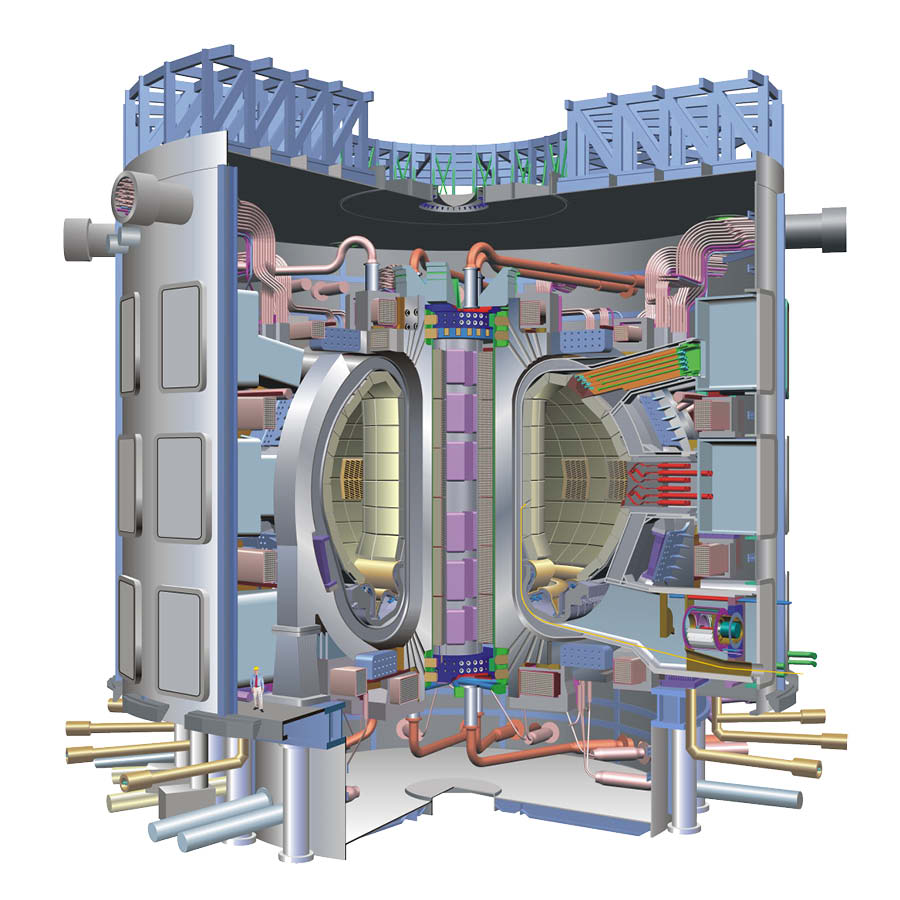A Sun in Our Hands
Lighting a miniature Sun on Earth and using it as a source of energy is the dream of physicists and engineers working in nuclear fusion. Researchers consider this energy source to be clean and inexhaustible, and it has made significant progress since its early days. Advances in nuclear fusion technology promise to revolutionize our ability to generate sustainable, emission-free energy. With projects like ITER—currently under construction in Cadarache, France—the scientific community is steadily moving towards turning this vision into reality.
21 de mayo de 2024

Getting Closer to the Energy of the Stars
ITER will operate using the same process that powers the Sun and the stars: nuclear fusion. This is the opposite of the process used in nuclear power plants, known as fission. In fission, energy is released when a massive atomic nucleus breaks into smaller parts. In fusion, on the other hand, light nuclei (like hydrogen) merge to form a single heavier nucleus (helium).
The Energy of Fusion

The hotter it gets, the faster atoms move. Inside the Sun, temperatures reach about 10 million degrees. This causes hydrogen atoms to collide at high speeds and overcome the electrostatic repulsion between their positively charged nuclei. When the nuclei of two hydrogen atoms fuse, they form a helium atom, which is heavier. However, the mass of the resulting helium atom is slightly less than the combined mass of the original hydrogen atoms—some of the mass is lost. Where did it go? It is converted into a large amount of energy, as described by Einstein’s formula (E=mc²): the small loss of mass (m), multiplied by the speed of light squared (c²), results in a huge amount of energy (E) derived from fusion. Since the Sun converts about 600 million tons of hydrogen into helium every second, the amount of energy produced is enormous.
The Secret to Confining a Star: the Tokamak

Fusion occurs in stars at temperatures around 10 million degrees. Some scientists have claimed to have achieved “cold fusion,” inducing this process at room temperature, but these experiments have not been reproducible. Therefore, ITER aims to achieve “hot fusion” by heating a gas (like a mixture of deuterium and tritium, two isotopes of hydrogen) to 100 million degrees—about ten times hotter than the Sun. At these temperatures, the gas becomes plasma, the fourth state of matter (different from solid, liquid, or gas), consisting of a collection of protons and neutrons. In this state, fusion is very likely. For fusion to occur, two atomic nuclei must come very close together, which is very difficult because positive charges repel each other. To overcome this repulsion, the nuclei must collide at high speed. This is achieved by increasing the temperature. While the Sun retains the plasma through gravity, this is not possible in a reactor. To confine the plasma, ITER will use magnetic forces, enclosing the substance in a doughnut-shaped chamber called a tokamak.
A Clean, Safe, and Almost Inexhaustible Energy Source
Fusion reactors do not rely on a “chain reaction” like conventional reactors, which risk losing control of the process. In fusion reactors, stopping the plasma flow halts the reaction, making this technology ultra-safe and clean. Its promoters claim that this technology would not only be ultra-safe, but also clean. There would be no issue with nuclear waste; only small portions of the tokamak would be activated and could be reused after 100 years. Fusion energy promises to be virtually inexhaustible: one kilogram of fusion fuel produces the same energy as 10 million kilograms of fossil fuel, and its constituents are more abundant on Earth (tritium reserves can last thousands of years, and deuterium billions). The main challenge is bringing this technology from theoretical viability to practical applicability. This is ITER’s goal, expected to be achieved within a few decades. For this reason, some researchers and environmentalists are calling for more investment in this project, given the urgency of climate change and global warming. The project’s promoters are optimistic, noting that the success rate of plasma physics experiments has steadily increased over the past 40 years. The growth rate is comparable to the advances seen in transistors and particle accelerators.
WRITTEN BY Michele Catanzaro
Further Information
Illustrations credits
- A Sun in Our Hands – Oriol Massana
- Tokamak – Iter Organization











Leave a Reply